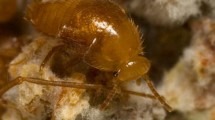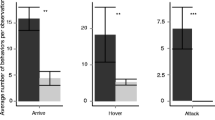Abstract
Most ants live in closed societies from which non-members are excluded through fighting or ritualized displays to protect colony resources. Nestmate recognition is the process by which ants discriminate nestmate from non-nestmate ants. Ants use cues coded in mixtures of long-chain hydrocarbon compounds on the cuticle as nestmate recognition cues. Pavement ants (Tetramorium caespitum) form conspicuous wars between neighboring colonies that are organized after workers meet and make the decision to fight after assessing nestmate recognition cues. These wars involve thousands of individuals. Fighting is ritualized and few ants die in the process. We identified 24 cuticular hydrocarbon compounds, above 1% in relative abundance, in the profile of pavement ants with chain lengths ranging from 15 to 31 carbon atoms. Cuticular lipids contained, in order of abundance: mono-methyl alkanes (45–56%), n-alkanes (range: 16–40% relative abundance), and alkenes (10–20%), with small or trace amounts of di-methyl, tri-methyl alkanes and fatty acids. Results from behavioral tests show that pavement ants assess information in cuticular hydrocarbon profiles to recognize both conspecific and heterospecfic (Pogonomyrmex occidentalis and Camponotus modoc) non-nestmate ants and that the relative abundance of methyl-branched alkanes and alkenes codes for nestmate status, at least for conspecific interactions. Our data add to a growing body of knowledge about how ants use cuticular hydrocarbon based nestmate recognition cues to prevent the intrusion of non-nestmates in to colony space.



Similar content being viewed by others
References
Akino T, Yamamura K, Wakamura S, Yamaoka R (2004) Direct behavioral evidence for hydrocarbons as nestmate recognition cues in Formica japonica (Hymenoptera : Formicidae). Appl Entomol Zool 39:381–387
Astruc C, Malosse C, Errard C (2001) Lack of intraspecific aggression in the ant Tetramorium bicarinatum: A chemical hypothesis. J Chem Ecol 27:1229–1248
Bjorkman-Chiswell BT, Van Wilgenburg E, Thomas ML, Swearer SE, Elgar MA (2008) Absence of aggression but not nestmate recognition in an Australian population of the Argentine ant Linepithema humile. Insect Soc 55:207–212
Bos N, d’Ettorre P (2012) Recognition of social identity in ants. Front Psychol 3:83–93
Brandstaetter AS, Rössler W, Kleineidam CJ (2011) Friends and foes from an ant brain's point of view–neuronal correlates of colony odors in a social insect. PLoS One 6:e21383
Buback AN, Yaeger JDW, Renner KJ, Swallow JG, Greene MJ (2016) Neuromodulation of nestmate recognition decisions by pavement ants. PLoS One 11:e0166417
Buczkowski G, Kumar R, Suib SL, Silverman J (2005) Diet-related modification of cuticular hydrocarbon profiles of the Argentine ant, Linepithema humile, diminishes intercolony aggression. J Chem Ecol 31:829–843
Chen JSC, Nonacs P (2000) Nestmate recognition and intraspecific aggression based on environmental cues in Argentine ants (Hymenoptera : Formicidae). Ann Entomol Soc Am 93:1333–1337
Collignon B, Detrain C (2010) Distributed leadership and adaptive decision-making in the ant Tetramorium caespitum. Proc Roy Soc B 277:1267–1273
Crozier RH, Pamilo P. (1996) Evolution of social insects. Oxford University Press
Dani FR, Jones GR, Corsi S, Beard R, Pradella D, Turillazzi S (2005) Nestmate Recognition Cues in the Honey Bee: Differential Importance of Cuticular Alkanes and Alkenes. Chem Senses 30:477–489
Esponda F, Gordon DM (2015) Distributed nestmate recognition in ants. Proc Royal Soc B. https://doi.org/10.1098/rspb.2014.2838
Ettershank G, Ettershank JA (1982) Ritualised fighting in the meat ant Iridomyrmex purpureus (Smith) (Hymenoptera: Formicidae). Aust J Entomol 21:97–102
Gibbs AG (1998) Water-proofing properties of cuticular lipids. Am Zool 38:471–482
Gibbs AG, Rajpurhoit G (2010) Cuticular lipids and water balance. Insect Hydrocarbons: Biology, biochemistry, and Chemical Ecology. Cambridge Press, Cambridge, pp 100–120
Greene MJ, Gordon DM (2003) Cuticular hydrocarbons inform task decisions. Nature 423:32
Greene MJ, Gordon DM (2007) Structural complexity of chemical recognition cues affects the perception of group membership in the ants Linepithema humile and Aphaenogaster cockerelli. J Exp Biol 210:897–905
Greene MJ, Pinter-Wollman N, Gordon DM (2013) Interactions with combined chemical cues inform harvester ant foragers' decisions to leave the nest in search of food. PLoS One 8(1):e52219. https://doi.org/10.1371/journal.pone.0052219
Guerrieri FJ, Nehring V, Jorgensen CG, Nielsen J, Galizia CG, d'Ettorre P (2009) Ants recognize foes and not friends. Proc R Soc Lond B Biol Sci 276:2461–2468
Hefetz A, Errard C, Chambris A, Le Negrate A (1996) Postpharyngeal gland secretion as a modifier of aggressive behavior in the myrmicinc ant Manica rubida. J Insect Behav 9:709–717
Hölldobler B (1976) Tournaments and slavery in a desert ant. Science 192:912–914
Hölldobler B (1982) Interference Strategy of Iridomyrmex pruinosum (Hymenoptera: Formicidae) during Foraging. Oecologia 52:208–213
Hoover KM, Bubak AN, Law IJ, Yeaeger JDW, Renner KJ, Swallow JG, Greene MJ (2016) The organization of societal conflicts by pavement ants Tetramorium caespitum: an agent-based model of amine mediated decision making. Current Zool 62:277–284
Howard RW, Blomquist GJ (2005) Ecological, behavioral, and biochemical aspects of insect hydrocarbons. Annu Rev Entomol 50:371–393
Ichinose K (1991) Seasonal variation in nestmate recognition in Paratrechina flavipes (Smith) worker ants (Hymenoptera: Formicidae). Anim Behav 41:1–6
Ichinose K, Lenoir A (2010) Hydrocarbons detection levels in ants. Insect Soc 57:453–455
Lahav S, Soroker V, Hefetz A (1999) Direct behavioral evidence for hydrocarbons as ant recognition discriminators. Naturwissenschaften 86:246–249
Liang D, Silverman J (2000) “You are what you eat”: Diet modifies cuticular hydrocarbons and nestmate recognition in the Argentine ant, Linepithema humile. Naturwissenschaften 87:412–416
Liang D, Blomquist GJ, Silverman J (2001) Hydrocarbon-released nestmate aggression in the Argentine ant, Linepithema humile, following encounters with insect prey. Comp Biochem Physiol B, Biochemistry & Molecular Biology 129:871–882
Lucas C, Pho DB, Jallon JM, Fresneau D (2005) Role of cuticular hydrocarbons in the chemical recognition between ant species in the Pachycondyla villosa species complex. J Insect Physiol 51:1148–1157
Martin SJ, Helanterae H, Drijfhout FP (2008) Evolution of species-specific cuticular hydrocarbon patterns in Formica ants. Biol J Linn Soc 95:131–140
Martin SJ, Drijfhout FP (2009a) Nestmate and Task Cues are Influenced and Encoded Differently within Ant Cuticular hydrocarbon Profiles. J Chem Ecol 35:368–374
Martin S, Drijfhout FP (2009b) A Review of Ant Cuticular Hydrocarbons. J Chem Ecol 35:1151–1161
McGlynn TP (1999) Other ant invaders. TREE 14:489–489
Menzel F, Schmitt T, Blüthgen N (2009) Intraspecific nestmate recognition in two parabiotic ant species: acquired recognition cues and low inter-colony discrimination. Insect Soc 56:251–260
Morel L, Vander Meer RK, Lavine BK (1988) Ontogeny of nestmate recognition cues in the red carpenter ant (Camponotus floridanus) – behavioral and chemical evidence for the role of age and social experience. Behav Ecol Sociobiol 22:175–183
Nelson DR, Blomquist GJ (1995) Insect Waxes. In: Hamilton RJ (ed) Waxes: Chemistry, Molecular Biology and Functions. The Oily Press, Christie, pp 1–90
Ozaki M, Wada-Katsumata A, Fujikawa K, Iwasaki M, Yokohari F, Satoji Y, Nisimura T, Yamaoka R (2005) Ant nestmate and non-nestmate discrimination by a chemosensory sensillum. Science 309:311–314
Plowes NJR (2008) Self organized conflicts in territorial ants. ProQuest, Ann Arbor
Roulston TH, Buczkowski G, Silverman J (2003) Nestmate discrimination in ants: effect of bioassay on aggressive behavior. Insect Soc 50:151–159
Roux O, Martin J-M, Ghomsi NT, Dejean A (2009) A non-lethal water-basd removal-reapplication technique for behavioral analysis of cuticular compounds of ants. J Chem Ecol 35:904–912
Scharf ME, Ratliff CR, Bennett GW (2004) Impacts of residual insecticide barriers on perimeter-invading ants, with particular reference to the odorous house ant, Tapinoma sessile. J Econ Entomol 97:601–605
Sharma KR, Enzmann BL, Schmidt Y, Moore D, Jones GR, Parker J, Berger SL, Reinberg D, Zwiebel LJ, Breit B, Liebig J, Ray A (2015) Cuticular Hydrocarbon Pheromones for Social Behavior and Their Coding in the Ant Antenna. Cell Rep 12:1261–1271
Steiner FM, Schlick-Steiner BC, Buschinger A (2003) First record of unicolonial polygyny in Tetramorium cf. caespitum (Hymenoptera, Formicidae). Insect Soc 50:98–99
Sturgis S, Gordon DM (2012) Nestmate recognition in ants (Hymenoptera, Formicidae): A review. Myrmecol News 16:101–110
Torres CW, Brandt M, Tsutsui ND (2007) The role of cuticular hydrocarbons as chemical cues for nestmate recognition in the invasive Argentine ant (Linepithema humile). Insect Soc 54:363–373
Vander Meer RK, Morel L (1998) Nest-mate recognition in ants. In: Vander Meer RK, Breed MD, Espelie KE, Winston ML (eds) Pheromone Communication in Social Insects: Ants. Bees and TermitesWestview Press, Boulder, Wasps, pp 79–103
van Wilgenburg E, van Lieshout E, Elgar M (2005) Conflict resolution strategies in meat ants (Iridomyrmex purpureus): ritualised displays versus lethal fighting. Behaviour 142:701–716
van Wilgenburg EV, Torres CW, Tsutsui ND (2010) The global expansion of a single ant supercolony. Evol Appl 3:136–143
van Zweden JS, d’Ettorre P (2010) Nestmate recognition in social insects and the role of hydrocarbons. Insect hydrocarbons: Biology, Biochemistry and Chemical Ecology 11. Cambridge Press, Cambridge, pp 222–243
Wagner D, Tissot M, Cuevas W, Gordon DM (2000) Harvester ants utilize cuticular hydrocarbons in nestmate recognition. J Chem Ecol 26:2245–2257
Whitehouse MEA, Jaffe K (1995) Nestmate recognition in the leaf-cutting ant Atta laevigata. Insect Soc 42:157–166
Acknowledgements
This work was supported, in part, by USDA/CSREES/NRI;UCD Project # 3533316. We thank Kevin Hoover and William Schuman for comments on the manuscript. The authors thank Claire Chen for her work identifying pavement ant cuticular hydrocarbon compounds.
Author information
Authors and Affiliations
Corresponding author
Electronic supplementary material
ESM 1
(XLSX 11 kb)
Rights and permissions
About this article
Cite this article
Sano, K., Bannon, N. & Greene, M.J. Pavement Ant Workers (Tetramorium caespitum) Assess Cues Coded in Cuticular Hydrocarbons to Recognize Conspecific and Heterospecific Non-Nestmate Ants. J Insect Behav 31, 186–199 (2018). https://doi.org/10.1007/s10905-017-9659-4
Revised:
Accepted:
Published:
Issue Date:
DOI: https://doi.org/10.1007/s10905-017-9659-4




